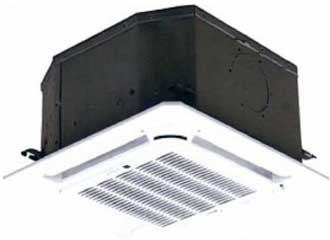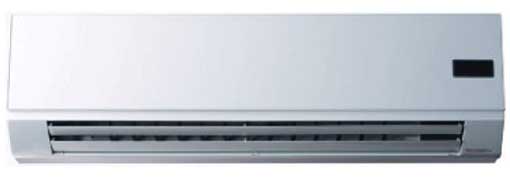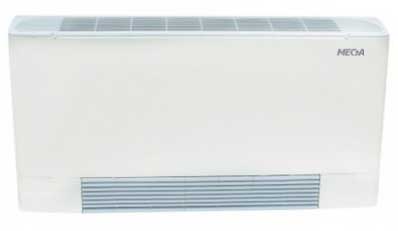- Cooling and Ventilation Equipment
- 0 likes
- 3065 views
- 0 comments
Fan Coil Unit Selection Tips
Want to use fan coil units to heat and cool the space of choice but you are not sure of the type, capacity, brand, price, and specifications that suit your purpose? Read on to find the answers to all your questions on price, technical specifications, and the best ceiling-mounted, floor-standing, wall-hung, and channel fan coil units on the market.
- The fan coil is the smallest component in an air conditioning system, mediating the transfer of energy from water to the air, and is composed of at least a coil, Electro-Motor, and an aeration fan.
- Fan coils are manufactured in different types from the standpoint of installation method, appearance, and application, and are available in ceiling, wall-mounted, floor-mounted, cassette, and ducted models.
- Regular fan coil units often integrate a single coil or two pipes and are not capable of simultaneous switching between cooling and heating modes—unless with four-way electric valves installed.
- Fan coil units can supply cooled air in the summer and heated air in the winter by running the air through copper coils passing cold or hot water.
- Typically, fan coils are often used in cases where we need to separate the control over the temperature in different spaces and to prevent the exchange or displacement of air and contaminants between areas.
- Floor-mounted fan coil units are available with capacities typically ranging between 200 and 1200 Cubic Feet per Minute (CFM) and in both vertical and horizontal models.
- Ceiling-mounted fan coil units that come in both cabinet and exposed models are available in a range of capacities from 200 to 1200 CFM and are installed over the drop ceiling (usually at the entrance to the room).
Click to view brands, models, and different types, find out the price, and Buy A FAN COIL UNIT.

- Further, ceiling-mounted, cassette fan coil units are available that have their coils installed above the drop ceiling and can be controlled by both a thermostat and using a remote control.
As far as airflow direction is concerned, the cassette fan coil unit may come in one-way or four-way models and can be of either two-pipe or four-pipe types.
- Moreover, the recently introduced, wall-mounted fan coil units have found popularity with construction contractors.

- Ducted fan coil units are also available in a range of capacities from 600 to 2000 CFM.

- Before placing an order for a fan coil, please learn whether the pipes will be installed on the left or the right.
Important Factors in Selecting a Fan Coil System
- Type: Fan coil units are available in different types, including floor-mounted, horizontal, sloped-top, built-in units, ceiling-mounted, four-way cassette, wall-mounted (similar to a mini-split), and ducted fan coil units that can be selected depending on the case of usage.
- Capacity: The first factor as regards selecting a fan coil is its heating or cooling capacity. When calculating the fan coil capacity—according to the total refrigeration load (both sensible and latent) of the space—base your calculations on the capacity at medium speed. Consult the following table for estimating the required capacity of the fan coil to be installed in a residential building in a temperate climate such as in Tehran (the capacity of fan coil units is often reported in CFM, which is the cubic feet of air supply from the fan per minute).

- The fan coil capacities presented in the table for different floor areas are estimates at the design indoor temperature and maximum fan speed. At medium speed, the correction factor for the air supply of fan coil units is approximately 0.8 relative to top speed and around 0.85 for cooling and heating capacity. You can contact our consultants at DamaTajhiz for further information.

- Dimensions: The selected fan coil must be fit for installation in the space planned for it. Dimensions are particularly important for ceiling-mounted and cassette fan coil units (notice: re-check all dimensions before placing an order).
Coil: The coil is where the cold or hot fluid passes and often consists of copper tubes and aluminum fins.
The arrangement of the tubes, the number of rows, protective coatings of the fins (bluefin and gold fin), tube material, number of fins in unit length, and their curve form are what distinguish between different makes.
Often, three rows of 3/8 in copper tubes are used to make the coil, however, using a double-row configuration with 1/2 in tubes will reduce pressure drop in the working fluid, in addition to improving the efficiency of the equipment. In some cases, to allow for the simultaneous supply of hot and cold air during the day, or for the different spaces in a luxury apartment, fan coil units with two separate coils are used (one for maintaining a flow of cold water from the chiller, another for the supply of hot water from the boiler). These are known as four-pipe fan coil units.
Casing: The fan coil unit should come with an integrated casing to prevent rattling noises made by loose parts with vibration.
- In other words, two-pipe fan coil units are equipped with only one coil, one supply line, and one return line, whereas their four-pipe counterparts feature two coils, and consequently, one pair of supply–return lines for hot water, and another for cold water.
- Four-pipe fan coil units supply both hot and cold air to space during the day, as well as allowing for heating one part of the building while cooling another.
- Motor: Three up to eight-speed electric motors are available for fan coil units. Further, the electric motor can be integrated into the unit or detachable for maintenance. Other types are also offered that differ in their shaft bushings and bearings, which affect their long-term performance and noise level. The fan coil motor must be low-noise, multi-speed, and equipped with reliable ball bearings to keep the noise from the working equipment below 35 dB.
- Fan: The aeration fan is responsible for moving the air and promoting its convection over the coil. Different manufacturers use different fan designs based on the noise level and the required air pressure for crossing the coil, ventilator, or ducts. These fans are generally made of metal or some plastic, each with its unique advantages and drawbacks, limiting the choices according to the application.
The fans, driven by electric motors (available in several types and models), often come in low-pressure (30 Pa) and high-pressure (20 Pa) types for ducted units.
It is best to use metal centrifugal fans in the fan coil unit for maintaining dynamic balance during long periods of operation to ensure a perfect air supply. High-quality polyamides are also acceptable materials that are much cheaper. Non-metal fans are not recommended for climates with cold winters that require maintaining the temperature of the water circulating a central system around 80 °C, for it can deform the fan in the long run. - Working Pressure: Considering that the water pressure in the coil will exceed 6 bar in buildings taller than 15 stories, this factor is of great importance in selecting a fan coil system for a high-rise.
- Appearance: One shall also note how the fan coil unit—particularly, the floor-mounted models—would appear as a component of the interior design.
- Control: At startup, the electric motor of the fan coil unit can be adjusted both manually and automatically but the best approach—particularly, for ceiling-mounted, wall-mounted, and cassette fan coil units—is to use a three-stage, two-season automatic thermostat and a three-way electric valve.
- Although floor-mounted fan coil units traditionally come with manual On/Off switches and speed controllers, installing an automatic room thermostat is essential to control the function of fan coil units and optimize energy consumption. Basically, the room thermostat installed 140 cm from the floor, away from the supply air blowing from the fan coil unit and direct sunlight, serves to switch the unit on and off and to control the fan speed.
- In a supplemental method using a slow-opening two-way electric valve or a three-way motor-operated valve and by implementing a bypass route, the command from the thermostat installed in the space can be used to regulate the circulation of cold or hot water supply to the fan coil unit, thus allowing to accurately adjust the cold or hot air supply by the controller.
Price: Price is a determining factor in the purchase of any product. However, when selecting a fan coil system, the thermal comfort of the residents, durability, noise, efficiency, capacity, and appearance come first.
Overall, selecting a fan coil unit is a function of the building architecture, as well as its use, and different models—regardless of the quality of their production—do not have a general advantage over one another and must be selected according to the installation requirements.

Advantages of the fan coil unit
The main advantage of the fan coil is that its piping system requires less space. This device can also work with a chiller and central heating system. It is also possible to control different spaces separately to reduce energy costs. This device allows you to control each room individually. Since this system can be heated even with low water temperatures, it is, therefore, suitable for areas where heat production is done solely by solar panels. When installing fan coils in existing buildings, the wiring and piping are simpler than the ducts required for all-air installations.
Technical Notes on Implementing the Fan Coil System
- To calculate the required flow rate of cold water for cooling, divide the total refrigeration load (in BTU) in each room of the building by 5000 (or divide it in kcal/hr by 1250). Accordingly, 1/2 in tubes are used for both cold and hot supply and return lines to 200 CFM fan coil units, whereas 3/4 in tubes are used in 300 and 400 CFM units, 1 in tubes are used in 1000 CFM units, and 1 1/4 in tubes are used in fan coil units of up to 1200 CFM and ducted fan coil units of up to 1800 CFM.
- Installing a flow switch on the evaporator output path (chilled water) to the cooling coil of the air conditioning equipment (including fan coil and air handling units) is necessary for commanding the chiller to stop when the circulator pumps in the refrigeration circuit shut down.
- Given the higher heating capacity of fan coil units than radiators of similar sizes, in older buildings, installing a fan coil system instead of radiators (only for heating) is only possible if the piping runs through the floor (and not in the wall supporting the unit).
- Given the significance of the dynamic balance of the aeration fan as regards the performance of fan coil units and their direct impact on the durability of the ball bearing motor, make sure to have the fan mounted in place perfectly horizontally to maintain the dynamic balance of the fan.
- To facilitate the maintenance of the air conditioning equipment, it is essential to install a cut-off valve at both the inlet and outlet of the unit with a fitting union nut (same size as the branch pipe).
- It is essential to install a 1/2 in drain line on the tray under the coil to collect the moisture distilled on the coil of the unit in the summer.
Similarly, if you have any additional questions about buying fan coil, floor fan coils or ceiling fan coils, wall fan coils, and channel fan coils, you can contact the DamaTajhiz company.
You can also read the article THE DIFFERENCE BETWEEN UNIT HEATER AND FAN COIL for more information.
Final speech
The specialized collection (Damatajhiz) (the first and most reliable authority in the country in the field of building facilities equipment and all air conditioning devices), offers you all kinds of sand filters and hundreds of other products, guaranteeing the originality of the product, valid warranty, and reasonable price. In addition, if you have any questions about choosing and comparing the brands of this product, you can get free advice from the heating equipment experts.
In Iran, the first and most famous specialized group in the field of building installation equipment, air conditioners, and all equipment for swimming pools, saunas, and jacuzzis since 2004, DamaTajhiz is a specialized group. Refer to the time of this group. For more information, you can get advice from the experts of DamaTajhiz Engineering and Production Company by calling 021-88822550.

We are waiting for your call and look forward to meeting you at the DAMATAJHIZ group
By sharing the above article on social networks, let your friends know about its important content.




Comments (0)